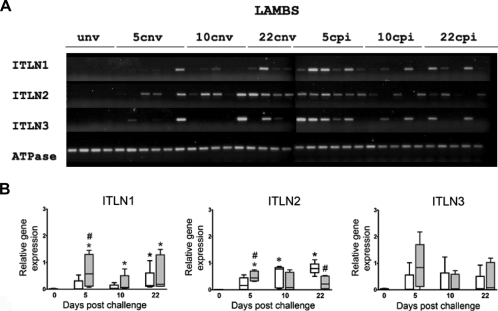Figure 4.
(A) Ethidium bromide gel (1.4%) of sITLN 1, 2 and 3 transcripts in lambs; unv, cnv (days 5, 10, 22) and cpi (days 5, 10 and 22). Expression of the housekeeping gene sheep ATPase is shown for comparison. Group numbers were as follows: unv, 22 cnv (n = 4), groups 10 cnv, 10 cpi, 22 cpi (n = 5) and groups 5 cnv, 5 cpi (n = 6). (B) Box and whisker plots showing relative transcript expression by RT-PCR in abomasal mucosa of unv, T. circumcincta cnv and T. circumcincta cpi lambs. No unchallenged previously infected group was present in this experiment. The house keeping gene was sheep ATPase. Semi-quantitative RT-PCR was carried out as described in Materials and methods. The naïve groups are shown as clear black boxes, whilst the previously infected groups as hatched grey boxes. Boxes represent the 25th and 75th quartiles, median is shown within the box, whiskers represent the range of the data. Asterix represents significant difference between cnv (*) or cpi (*) and unv group, whilst hatch (#) represents significant difference between cnv and cpi groups at the same time points post challenge. A Kruskal-Wallis test was used to compare all groups and a Mann–Whitney U as a post hoc test. p < 0.05 was considered significant.

